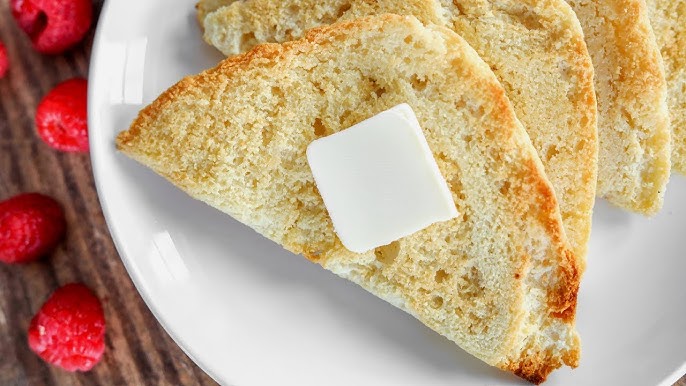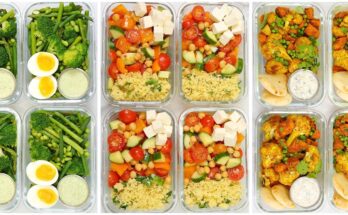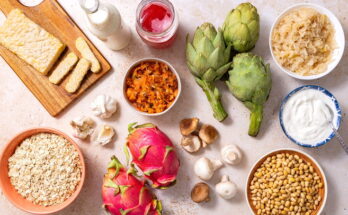Low Carb Bread Recipe: If you’ve ever tried following a low carb or keto lifestyle, you know how challenging it can be to give up bread. Bread is a staple in almost every household—it’s comforting, versatile, and pairs well with just about any meal. However, traditional bread is high in carbohydrates, which can spike blood sugar levels and interfere with weight loss or low-carb goals. That’s where low carb bread comes in.
Low carb bread is a healthier alternative that allows you to still enjoy the deliciousness of bread without overloading on carbs. By using ingredients like almond flour, coconut flour, flaxseeds, and psyllium husk, you can create bread that is not only low in carbohydrates but also high in fiber and healthy fats. The result is a filling, flavorful loaf that supports your diet instead of working against it.
But this isn’t just about carb counting. Low carb bread can also benefit your digestion, help maintain steady energy levels, and even assist in weight management. Whether you’re on a ketogenic diet, diabetic, gluten-sensitive, or simply looking for a healthier bread option, this recipe will give you the perfect balance between flavor and nutrition.
In this guide, we’ll walk you through the ingredients, step-by-step process, variations, and tips so you can bake the perfect loaf right in your kitchen. By the end, you’ll realize that making bread doesn’t need to be intimidating—it can actually be a fun, rewarding, and delicious experience.
Why Low Carb Bread is Becoming Popular
The growing popularity of low carb bread isn’t just a trend—it’s part of a much larger movement towards healthier eating and sustainable lifestyles. More people are becoming aware of how carbs affect their bodies. Diets like keto, paleo, and Atkins have made low carb eating mainstream, leading to a demand for bread alternatives that fit into these lifestyles.
The traditional loaf of bread contains anywhere between 12 to 20 grams of carbs per slice. For someone on a keto diet, where the daily carb limit is often restricted to 20–50 grams, just one slice could take up almost the entire allowance! Low carb bread solves this problem by cutting down the carbs significantly—sometimes to as low as 1–2 grams per slice.
What makes it even better is that most low carb breads are rich in fiber and protein, which means you stay full longer. They also prevent the blood sugar spikes that are commonly linked to regular bread. For diabetics, this is a game-changer. For fitness enthusiasts, it means steady energy for workouts without the crash.
The rise of gluten intolerance and celiac disease has also pushed people to look for alternatives. Low carb breads often skip wheat flour, replacing it with nut and seed flours, which makes them naturally gluten-free. This combination of health benefits and dietary inclusivity is why you’ll find low carb bread recipes trending all over social media, food blogs, and cookbooks.
Health Benefits of Low Carb Bread
Switching to low carb bread can bring several benefits that go far beyond just cutting carbs. Let’s take a look at why you might want to consider incorporating it into your diet:
- Supports Weight Loss – Since low carb bread contains fewer carbs and more fiber, it keeps you fuller for longer. This naturally reduces cravings and helps control overall calorie intake.
- Improves Blood Sugar Control – Regular bread can cause rapid spikes in blood sugar levels, but low carb bread helps stabilize it, making it safer for diabetics.
- Boosts Energy Levels – Instead of the energy crash you often feel after eating traditional bread, low carb bread provides sustained energy.
- Promotes Gut Health – The high fiber content supports healthy digestion and prevents constipation.
- Rich in Nutrients – Almond flour, coconut flour, and flaxseeds are loaded with vitamins, minerals, and omega-3 fatty acids, making your bread not just low carb but nutrient-dense.
For anyone struggling with bloating, cravings, or energy dips after eating bread, switching to a low carb version can make a noticeable difference. Think of it as a smarter, healthier choice that still lets you enjoy one of life’s simplest pleasures.
Who Should Try Low Carb Bread?
You might be wondering—who exactly should give low carb bread a try? The short answer: almost anyone looking to make healthier choices. But let’s break it down:
- Keto Dieters – If you’re following a ketogenic lifestyle, low carb bread is practically essential. It allows you to satisfy bread cravings without getting kicked out of ketosis.
- Diabetics – Since it has a much lower glycemic impact, it’s an excellent bread substitute for managing blood sugar levels.
- Gluten-Intolerant Individuals – Many low carb bread recipes skip wheat flour altogether, making them gluten-free and easier to digest.
- Weight Watchers – If you’re counting calories or trying to slim down, low carb bread keeps you full without adding too many calories.
- Health-Conscious Individuals – Even if you’re not on a strict diet, switching to a healthier bread option can improve digestion, boost energy, and support overall wellness.
Of course, low carb bread may not be for everyone. If you have nut allergies, you’ll need to choose recipes that avoid almond flour and other nut-based ingredients. But with so many variations available, there’s almost always an option that works for your preferences and dietary needs.
Ingredients You’ll Need
Now, let’s talk about the heart of the recipe: the ingredients. One of the best things about baking low carb bread is that it doesn’t require a long list of complicated items. In fact, you might already have most of these in your pantry. The ingredients can vary depending on the type of bread you want to make, but here are the essentials:
Core Ingredients for Low Carb Bread
- Almond Flour (2 cups) – A popular low carb flour that gives bread a nutty flavor and soft texture.
- Coconut Flour (¼ cup) – Balances the almond flour and provides a subtle sweetness while keeping the bread fluffy.
- Psyllium Husk Powder (2 tbsp) – Key for creating a bread-like texture and structure.
- Baking Powder (1 tsp) – Helps the bread rise and stay light.
- Eggs (4 large) – Provide structure, moisture, and protein.
- Olive Oil or Melted Butter (2 tbsp) – Adds richness and keeps the bread soft.
- Warm Water (1 cup) – Activates the psyllium husk and helps form the dough.
- Salt (½ tsp) – Enhances flavor.
Optional Additions for Flavor and Texture
- Chia Seeds or Flaxseeds – For added fiber and crunch.
- Herbs and Spices (garlic powder, rosemary, thyme) – To give your bread a unique taste.
- Cheese (parmesan or cheddar) – For a savory, cheesy bread.
- Nuts or Seeds – Sunflower seeds, pumpkin seeds, or sesame seeds for texture.
Kitchen Tools and Equipment Required
- Mixing bowls
- Measuring cups and spoons
- Whisk or electric mixer
- Bread loaf pan (lined with parchment paper)
- Oven
The beauty of this recipe is its flexibility. You can swap ingredients, add your favorite flavors, or keep it as simple as you like. The main idea is to maintain a balance between structure (provided by psyllium husk and eggs) and flavor (from flours, seeds, and oils).
Step-by-Step Guide to Making Low Carb Bread
Making bread from scratch might sound intimidating, but this recipe is surprisingly easy once you understand the steps. Low carb bread doesn’t require yeast or long proofing times, which makes it quicker to prepare than traditional bread. Follow this step-by-step guide, and you’ll have a warm, golden loaf ready in about an hour.
Step 1 – Preparing the Ingredients
Start by gathering your ingredients: almond flour (or coconut flour), psyllium husk powder for structure, baking powder, salt, eggs, apple cider vinegar, and warm water. For added richness, you can also include butter or olive oil. These low-carb alternatives replace traditional wheat flour, keeping the bread light on carbs but full of flavor.
Step 2 – Mixing the Dough Properly
In a large mixing bowl, combine the almond flour, psyllium husk, baking powder, and salt. In another bowl, whisk the eggs with vinegar and a bit of warm water. Slowly add the wet mixture to the dry ingredients and stir until it forms a thick, sticky dough. The psyllium husk will absorb moisture and give the bread its chewy, bread-like texture.
Step 3 – Shaping and Setting the Dough
Transfer the dough to a parchment-lined baking tray or loaf pan. Shape it into a loaf or smaller rolls, depending on your preference. Let it rest for a few minutes so the psyllium husk can fully absorb the liquid and set the structure.
Step 4 – Baking the Bread Perfectly
Preheat your oven to 350°F (175°C). Bake the bread for 45–55 minutes (loaf) or 25–30 minutes (rolls), until the crust turns golden brown and a toothpick inserted into the center comes out clean. Avoid overbaking, as this can make the bread too dry.
Step 5 – Cooling and Serving the Bread
Remove the bread from the oven and let it cool completely on a wire rack before slicing. This step is important, as cutting too soon can make the bread gummy inside. Serve with butter, low-carb spreads, or use it for sandwiches.
Tips for Baking the Best Low Carb Bread
Even though this recipe is simple, little tweaks can make a big difference in the final result. Here are some tried-and-true tips to help you bake the best loaf every time:
- Use Fresh Ingredients – Old baking powder or stale almond flour can ruin the bread’s texture.
- Don’t Skip Psyllium Husk – It’s the secret ingredient that gives structure and bread-like chewiness.
- Experiment with Flavors – Add garlic powder, onion powder, or dried herbs for a savory twist.
- Control Moisture – If your loaf turns out too dry, add a bit more fat (butter, oil, or cream). If too wet, increase the psyllium husk slightly.
- Bake and Slice Thin – Low carb bread is more filling than regular bread, so thinner slices are often more satisfying.
Think of this recipe as a starting point. With practice, you’ll discover your favorite variations and adjustments to match your taste perfectly.
Common Mistakes to Avoid
Many beginners face the same challenges when making low carb bread. Here’s what to watch out for:
- Using the Wrong Flour – Regular flour can’t be substituted 1:1 with almond or coconut flour. Always follow low carb-specific recipes.
- Skipping the Eggs – Eggs provide structure. If you want egg-free bread, you’ll need substitutes like flax eggs, but the texture will be different.
- Overbaking – This dries out the loaf. Check at 40 minutes and adjust as needed.
- Cutting Too Soon – Bread needs time to set after baking. Cutting early leads to a crumbly mess.
- Expecting Regular Bread Texture – Low carb bread will be denser and more filling. Embrace the difference—it’s what makes it so satisfying!
Avoiding these pitfalls ensures that your bread turns out soft, flavorful, and perfect every single time.
Variations of Low Carb Bread
One of the best things about baking your own bread is the flexibility to experiment. Low carb bread doesn’t have to be boring or plain—there are countless variations you can try to suit your taste buds. Each version uses slightly different ingredients, giving you a unique texture, flavor, and nutritional profile. Here are some of the most popular options:
Almond Flour Bread
Almond flour is the most widely used base for low carb bread. It’s rich in healthy fats, protein, and vitamin E. Almond flour bread tends to have a light, nutty flavor and a soft, moist texture. It’s perfect for everyday sandwiches, toast, or even as a side with soups and stews.
- Best For: Those who want a versatile bread that tastes closest to regular bread.
- Tip: Always use fine, blanched almond flour for the best texture.
Coconut Flour Bread
Coconut flour has a naturally sweet taste and is extremely high in fiber. However, it’s very absorbent, which means you’ll need fewer amounts compared to almond flour. This bread is a little denser and slightly sweet, making it great for breakfast toast or even dessert-style breads.
- Best For: People who want a low-carb bread with a hint of sweetness.
- Tip: Always pair coconut flour with eggs to balance its absorbency.
Flaxseed Bread
Flaxseed meal is packed with omega-3 fatty acids, fiber, and plant-based protein. Bread made with flaxseeds is hearty, earthy, and slightly nutty. It’s also egg-free and vegan-friendly if you use water as a binder.
- Best For: Vegans and those who want a fiber-rich bread.
- Tip: Store flax meal in the fridge to keep it fresh and prevent bitterness.
Psyllium Husk Bread
Psyllium husk is a fiber powerhouse that gives bread its chewy, “real bread” feel. It creates an airy texture and helps hold everything together, which is why it’s often combined with almond or coconut flour.
- Best For: People who miss the chewy texture of wheat bread.
- Tip: Always use high-quality psyllium husk powder for consistent results.
By experimenting with these variations, you’ll never feel limited. In fact, you can combine these ingredients for the perfect customized loaf.
Nutritional Value of Low Carb Bread
Low carb bread isn’t just about cutting carbs—it’s also about adding nutrients. The ingredients used are far more nutrient-dense than refined wheat flour. Let’s break down the nutrition:
Calories per Serving
A single slice of low carb bread (depending on the recipe) usually ranges from 60–120 calories, compared to 150–200 calories in regular bread. That means you can enjoy it without worrying about excessive calories.
Macronutrient Breakdown
Here’s an average nutritional profile for one slice of almond flour-based low carb bread:
- Carbs: 2–4g net carbs
- Protein: 5–7g
- Fat: 6–9g (mostly healthy fats)
- Fiber: 3–5g
This balance makes it not only filling but also supportive of a keto or low carb diet.
Comparing to Regular Bread
Regular white bread:
- Carbs: 12–20g per slice
- Protein: 2–3g
- Fat: <1g
- Fiber: 1g or less
The difference is clear—low carb bread is a healthier choice with fewer carbs, more protein, and significantly more fiber. It’s a win-win for both flavor and nutrition.
Storage and Shelf Life
Homemade bread doesn’t contain preservatives, so storage is important. Luckily, low carb bread stores well with just a little care.
How to Store at Room Temperature
If you plan to eat the bread within 2–3 days, you can keep it at room temperature. Place it in an airtight container or wrap it tightly in plastic wrap to prevent it from drying out.
Refrigeration and Freezing Tips
For longer storage, refrigerate or freeze the bread:
- Refrigerator: Keeps fresh for up to 1 week. Store in a sealed bag or container.
- Freezer: Slice the bread first, then freeze in a freezer bag. This way, you can take out slices as needed. Frozen bread lasts up to 3 months.
How to Reheat Without Losing Texture
- Toast frozen slices directly in a toaster.
- For softer bread, wrap a slice in a damp paper towel and microwave for 15–20 seconds.
Proper storage ensures you always have fresh, healthy bread on hand without waste.
Serving Ideas
Once you’ve baked your loaf, the fun part begins—eating it! Low carb bread is versatile and can be used in countless ways, just like regular bread.
Low Carb Bread with Breakfast
- Toasted with butter or cream cheese.
- Avocado toast topped with eggs.
- A base for low carb French toast.
Sandwiches and Wraps
- Turkey and cheese sandwich for a quick lunch.
- BLT (bacon, lettuce, tomato) with mayo.
- Grilled cheese paired with a bowl of tomato soup.
Pairing with Soups and Salads
- Serve warm slices alongside low carb soups like broccoli cheddar or chicken soup.
- Use toasted slices as crunchy croutons for salads.
The possibilities are endless. Low carb bread gives you the freedom to enjoy all your favorite meals without the carb overload.
Low Carb Bread for Special Diets
Everyone’s dietary needs are different, and low carb bread can be adapted to fit most lifestyles.
Gluten-Free Option
Most low carb bread recipes are naturally gluten-free since they use almond or coconut flour instead of wheat flour. Just make sure all your ingredients are certified gluten-free.
Dairy-Free Option
If you’re avoiding dairy, simply replace butter with coconut oil or olive oil. Unsweetened almond milk can be used in place of cream if needed.
Vegan-Friendly Adaptation
To make it vegan:
- Replace eggs with flax eggs (1 tbsp ground flax + 3 tbsp water = 1 egg).
- Use plant-based butter or oil.
While the texture may differ slightly, these substitutions still produce a delicious, hearty loaf.
FAQs about Low Carb Bread Recipe
When it comes to low carb bread, there are always a few common questions people have before baking. Let’s address them here:
1. Can I make low carb bread without eggs?
Yes, but the texture will be different. Eggs give structure and fluffiness. For an egg-free option, you can use flax eggs (1 tablespoon ground flaxseed + 3 tablespoons water = 1 egg). However, the bread may be denser.
2. What’s the best flour for low carb bread?
Almond flour is the most popular and versatile choice. Coconut flour works too, but it requires more eggs due to its absorbency. Flaxseed and psyllium husk can also be used for texture and binding. Often, a mix of these flours works best.
3. Can I toast low carb bread like regular bread?
Absolutely! Low carb bread toasts beautifully. In fact, toasting enhances its flavor and helps crisp up the edges. Perfect for butter, spreads, or sandwiches.
4. How long does homemade low carb bread last?
At room temperature, it lasts 2–3 days in an airtight container. In the fridge, up to a week. For long-term storage, freeze it for up to 3 months. Always slice before freezing for convenience.
5. Does low carb bread taste like regular bread?
Not exactly—but close! The texture is denser, and the flavor has a slightly nutty or earthy undertone depending on the flour used. Many people find it even more satisfying because it’s rich and filling.
Conclusion
Switching to low carb bread doesn’t mean sacrificing taste or comfort—it means making a smarter choice that supports your health goals. With just a handful of wholesome ingredients like almond flour, psyllium husk, and eggs, you can create bread that’s not only low in carbs but also packed with fiber, protein, and healthy fats.
The best part? It’s easy, customizable, and versatile. You can enjoy it toasted for breakfast, build a hearty sandwich, or pair it with your favorite soups and salads. With a little practice, you’ll master this recipe and even experiment with your own variations.
So the next time you crave a warm slice of bread but don’t want the carb overload, remember—you now have the perfect recipe to bake a loaf that’s delicious, nutritious, and guilt-free.



